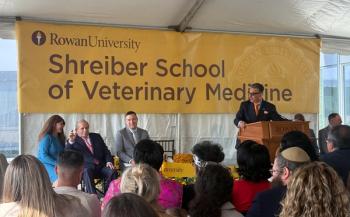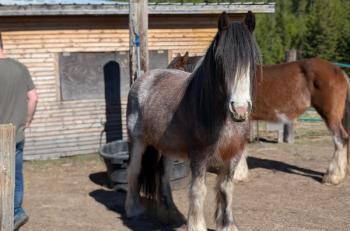
Cases of equine hepatic disease (Proceedings)
The problem oriented approach to liver disease involves identification of liver disease as a differential diagnosis for several problems.
The problem oriented approach to liver disease involves identification of liver disease as a differential diagnosis for several problems. In this discussion, we will discuss liver disease as a differential diagnosis for: icterus, increased liver enzymes, neurologic disease, fever ± colic, and weight loss. It is important in most cases whether the problem results from liver disease alone or liver disease with liver failure.
Icterus in horses can occur as a result of normal digestion of carotene pigments in grass and hay, fasting and anorexia (partial or complete), liver failure, or hemolysis. Forage consumption normally causes mild yellow discoloration of the sclera, plasma or serum, and tissues. For this reason, the "icterus" index in horses does not always correlate with plasma or serum bilirubin concentration. That is the sclera and membranes can be yellow with a normal bilirubin. Measurement of the total bilirubin concentration differentiates this situation simply.
Fasting hyperbilirubinemia results in elevations of total bilirubin concentration in horses without liver disease. It appears that bilirubin uptake into hepatocytes in horses is dependent on eating. It is possible that production of the protein responsible for bilirubin uptake (ligandin) is stimulated by eating. Dramatic elevations of indirect bilirubin (up to 15 mg/dl) can result from fasting. The key is that the direct (conjugated bilirubin) remains completely within the reference range (usually less than 1 mg/dl) during fasting or anorexia. Hepatic enzymes (gamma glutamyl transferase, aminoaspartase transferase, and sorbitol dehydrogenase) and bile acids remain normal during fasting.
When icterus is due to elevations of bilirubin due to hepatic failure, direct and indirect bilirubin are elevated thereby elevating total bilirubin, bile acids, and liver enzymes. The gamma glutamyl transferase (GGT) is an induction enzyme produced during dilation of the biliary tree. However, it is a sensitive indicator of any liver disease in the horse since hepatocyte swelling blocks canaliculi between cells causing biliary stasis and GGT production. Aspartate aminotransferase (AST) is leaked form hepatocytes during hepatocyte damage but is also an indicator of muscle damage. Alanine aminotransferase (ALT) does not leak appreciably from equine hepatocytes so this enzyme used in assessment of liver disease in small animals is not useful in horses. LDH is very nonspecific and not helpful in assessment of liver disease in horses. Sorbitol dehydrogenase is a specific indicator of hepatocyte damage but is labile requiring rapid delivery to the laboratory after collection. Bile acids can be assessed in horses by laboratories that measure total bile acids. Sample can be collected at any time before or after eating. Elevations up to 20 mmol/liter can occur in anorexic horses with other system disease. Elevations over 20 mmol/liter sensitively indicate hepatic failure.
Icterus due to hemolysis is generally accompanied by a drop in packed cell volume and red blood cell count. Liver enzymes and bile acids will commonly remain normal in these cases. Elevations of unconjugated bilirubin are most dramatic but concurrent elevations in conjugated bilirubin are not uncommon in horses with hemolysis.
In summary, laboratory evaluation of horses with icterus includes bilirubin (direct and indirect, GGT, AST (Never ALT or LDH) or SDH, OCT, PCV, and bile acids. An example occurred in an eight-year-old Tennessee Walking horse that developed icterus and limb swelling acutely while in the recovering stages of Streptococcus zooepidemicus induced pneumonia. Laboratory changes occurred as follows:
• GGT 21 (normal less than 32)
• AST 200 (normal less than 179)
• Bilirubin 7.2 mg/dl with direct 3.1
• Bile acids 12
• PCV 18
• Negative Coggins
This Tennessee Walking horse responded favorably to conservative management.
Another common scenario related to laboratory changes associated with the liver is when elevations in liver enzymes occur while performing screening blood work and signs compatible with liver answer disease are absent. Common examples occur during prepurchase examinations and elevations of GGT may occur without clinical disease. Elevations in GGT can occur nonspecifically in response to other disease resulting in liver perfusion changes and drug administration. However, elevations in GGT without clinical disease can also be and early indicator of bacterial cholangitis or chronic active hepatitis so should not be ignored. These laboratory changes are best handled by rechecking serum chemistry enzymes in 30 days. In most cases, transient elevations have resolved and persistent elevations are due to liver disease. If elevations persist beyond 6 to 8 weeks, liver ultrasound and liver biopsy are indicated.
Asymptomatic elevations in AST are also sometimes encountered. Mild elevations usually result from muscle leakage due to poor conditioning for level of training. This can be evaluated training via a sub maximal exercise tolerance test in which CPK is measured before, immediately after, and 6 and 24 hours after submaximal exercise (20 minutes on lounge line or treadmill at trot and cantor). In normal horses the CPK will increase immediately after exercise but will return to normal thereafter. In horses with muscle disease (poor training, PSSM, etc) the CPK will continue to rise.
Liver failure can result in neurologic signs (hepatoencephalopathy) due to accumulation of metabolites and amino acids not handled appropriately by the dysfunctional liver. However, horses with hepatoencephalopathy can also demonstrate peripheral nerve and spinal cord signs. A seven year old Thoroughbred mare presented head pressing and compulsively walking in a circle indicating maniacal cerebral disease. The mare demonstrated periods of obtundation during which she was not responsive to handlers. Mucous membranes were injected but the mare was not icteric. Cerebral signs accompanied by injected mucous membranes are most commonly associated with leucoencephalomalacia or hepatoencephalopathy. Leucoencephalomalacia results from ingestion of fusarium toxin most often obtained from moldy corn. Fusarium is a hepatic toxin (resulting in endotoxemia and injected mucous membranes) and neurotoxin (resulting in cerebral disease). Other differential diagnoses for the cerebral disease are meningitis, arbovirus (EEE, West Nile Virus) infection, and Herpes encephalitis. Diagnostic testing should include arbovirus serology, complete blood count, and serum chemistry (with a GGT). The serum chemistry results are as follows:
• GGT 145 U/L (normal less than 32)
• AST 1432 U/L (normal less than 179)
• Bilirubin 5.4 mg/dl with direct 2.1 mg/dl
• Bile acids 114 (normal less than 10)
The GGT and AST confirm liver disease. The bile acids are consistent with liver failure indicating that hepatoencephalopathy is the cause of the cerebral signs. Complete blood count reveals leucopenia and neutropenia consistent with endotoxemia accompanying liver failure. The following are differential diagnoses for the liver failure:
• Acute Hepatic Necrosis
• Cholangiohepatitis
• Chronic Active Hepatitis
• Cholelithiasis
• Pyrrolizidine Alkaloid toxicosis
Liver ultrasound reveals a slightly small liver and normal parenchyma and no biliary dilation suggestive of acute hepatic necrosis. Liver biopsy is pending. Treatment includes sedation with xylazine to control mania when necessary and intravenous glucose. Intravenous fluids and electrolytes are administered as needed and flunixin meglumine is used to reduce severity of endotoxemia. Branched chain amino acid supplements appear safe but afford little additional benefit. Oral antimicrobials may reduce intestinal ammonia production but are rarely used so to the minimal benefit and potential for colitis induction.
The mania progressed despite treatment necessitating euthanasia.
Colic can sometimes result from dilation of the bile ducts due to cholagiohepatitis and biliary stones resulting in bile stasis. It is not known whether diet composition predisposes to stone formation and the resulting stasis leads to infection or whether the infection results from retrograde infection of the biliary tree from the intestinal tract first and this serves as a nidus for stone formation. Antimicrobial treatment of infection is generally followed by passage of stones and recurrence is rare as long as antimicrobial treatment is continued until the GGT is normal. Other differential diagnoses for causes of colic and fever include colitis, enteritis, and peritonitis. A 9 year old Quarterhorse gelding had colic and fever that was treated with Trimethoprim sulfadiazine for 3 days which resulted in resolution. The clinical signs recurred and resolved again after Trimethoprim sulfadiazine therapy which was continued for seven days. After withdrawal of antimicrobials, the clinical signs recurred again. The following laboratory data were obtained:
• GGT 2712 U/L (normal less than 32)
• AST 279 U/L (normal less than 179)
• Total bilirubin 7.4 mg/dl with direct 3 mg/dl (normal total less than 2 mg/dl; direct < 1 mg/dl)
• Bile acids 110
• Clotting times normal
• BUN and glucose normal
• PT and PTT normal
• Complete blood count 4,100 cells per microliter (normal 6 to 12000)
Liver ultrasound revealed dilated bile ducts with hyperechoic stones. Liver biopsy and culture submitted. The tentative diagnosis was cholithiasis so broad spectrum antimicrobials were administered intravenously (penicillin and gentamicin). Broad spectrum antimicrobial therapy will commonly result in resolution of the colic signs within 1-2 days and the GGT should begin to decline quickly. In this horse the colic signs persisted and the GGT continued to climb (3126 U/L). Severe depression ensued. Exploratory laparotomy was recommended and a large bile stone was found in the common bile duct. This was expressed into the duodenum. Post operative recovery was uneventful. Antimicrobial therapy was continued for 6 weeks until GGT was normal. The horse returned to barrel racing and stones did not recur.
Newsletter
From exam room tips to practice management insights, get trusted veterinary news delivered straight to your inbox—subscribe to dvm360.






